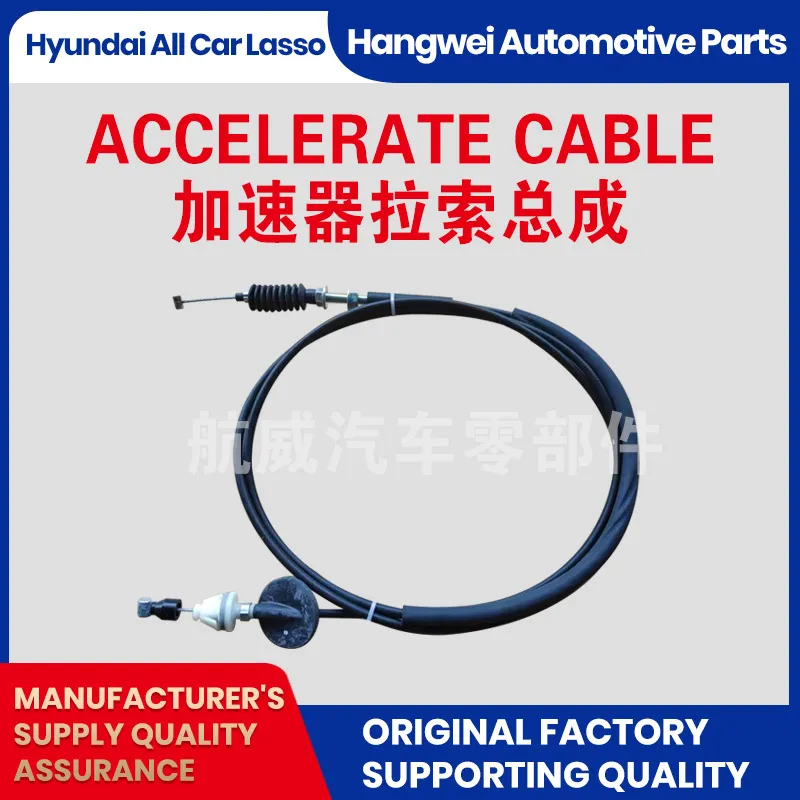throttle body cable
Understanding the Throttle Body Cable An Essential Component of Automotive Systems
The throttle body cable is a critical component of an automobile's throttle control system, serving as the link between the accelerator pedal and the throttle body itself. This cable plays a significant role in ensuring that an engine receives the correct amount of air and fuel mixture, allowing it to operate efficiently and respond to the driver’s commands promptly. Understanding how this cable works, its importance, and how to maintain it can enhance both driving experience and vehicle performance.
What is a Throttle Body and Throttle Body Cable?
The throttle body is a device located between the air intake filter and the intake manifold of an engine. Its primary function is to regulate the amount of air entering the engine in response to the position of the accelerator pedal. The throttle body cable is essentially a mechanical linkage that connects the accelerator pedal to the throttle body, enabling the driver to control the engine's speed seamlessly.
When the driver presses the accelerator pedal, the movement is transmitted through the throttle body cable. This pull activates a butterfly valve within the throttle body, which opens to allow more air into the engine. Simultaneously, this increased airflow is mixed with fuel in the combustion chamber, generating the power required to drive the vehicle. Proper functionality of the throttle body cable is vital for optimal engine performance.
The Importance of the Throttle Body Cable
1. Performance The throttle body cable ensures that there is a direct and responsive connection between the driver’s foot and the engine's power output. If the cable is damaged or fails, it can lead to poor acceleration or a complete loss of throttle control, severely affecting the vehicle's performance.
2. Safety A malfunctioning throttle body cable can pose significant safety risks. For instance, if the throttle becomes stuck open, the vehicle may accelerate uncontrollably, leading to potential accidents. Regular checks of the throttle body cable can help prevent such dangerous situations.
3. Fuel Efficiency An improperly functioning throttle body cable can potentially lead to increased fuel consumption. If the throttle does not open and close as it should, it can lead to an enriched or lean fuel mixture, causing the engine to work harder than necessary and consume more fuel.
Signs of a Failing Throttle Body Cable
throttle body cable

Being aware of potential signs of throttle body cable problems can help drivers take proactive measures. Some common indicators include
- Delayed Acceleration If there is a noticeable delay when pressing the accelerator, it could indicate a problem with the cable. - Sticking Throttle A throttle that does not return to its closed position when the accelerator pedal is released may signify a frayed or damaged cable. - Unresponsive Acceleration If the engine does not respond appropriately when accelerating, it may be due to a cable issue.
- Unusual Noises If the throttle body cable is rubbing against other components, it may produce grinding or squeaking noises.
Maintenance Tips
To ensure the longevity and proper functionality of the throttle body cable, regular maintenance is essential. Here are some key tips
- Visual Inspection Regularly check the throttle body cable for any signs of wear, fraying, or damage. Look for kinks or twists that could affect its operation. - Cleaning Keep the throttle body clean, as dirt and debris can affect the movement of the cable and the operation of the throttle body itself. - Lubrication Applying a suitable lubricant to the cable can reduce friction and improve its performance. However, be cautious not to use too much, as excess lubricant can attract dirt.
- Professional Servicing If you notice any signs of potential issues, consult a professional mechanic who can diagnose and replace the throttle body cable if necessary.
Conclusion
The throttle body cable is a vital component of modern automotive systems. Ensuring its proper function and maintenance is critical for optimal vehicle performance, safety, and fuel efficiency. By understanding how this cable operates and recognizing signs of wear or failure, drivers can take proactive steps to ensure their vehicles run smoothly and efficiently, enhancing their overall driving experience. Regular checks and proper care will go a long way in maintaining the health of this essential automotive component.
-
Workings of Clutch Pipe and Hose SystemsNewsJun.04,2025
-
The Inner Workings of Hand Brake Cable SystemsNewsJun.04,2025
-
The Secrets of Throttle and Accelerator CablesNewsJun.04,2025
-
The Hidden Lifeline of Your Transmission Gear Shift CablesNewsJun.04,2025
-
Demystifying Gear Cables and Shift LinkagesNewsJun.04,2025
-
Decoding Clutch Line Systems A Comprehensive GuideNewsJun.04,2025
